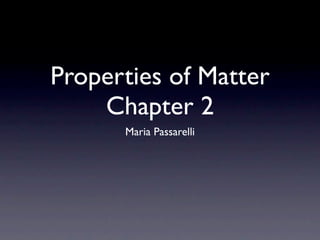
Properties of matter pp
- 1. Properties of Matter Chapter 2 Maria Passarelli
- 2. Pure Substances • Every sample of a given substancehas the same properties because a substance has a fixed, uniform composition
- 3. Elements • An element has a fixed composition because it contains only one type of atom. • An atom is the smallest particle of an element
- 4. Compounds Hydrogen+Oxygen =Water • A compound always contains two or more elements joined in a fixed proportion
- 5. Mixtures • The properties of a mixture can vary because the composition of a mixture is not fixed
- 6. Heterogeneous Mixtures • In a heterogeneous mixture, the parts of the mixture are noticeably different from one another
- 7. Homogeneous Mixtures • In a homogeneous mixture, the substances are so evenly distributed that it is difficult to distinguish one substance in the mixture from another
- 8. Solutions, Suspensions, and Colloids • Based on the size of its largest particles, a mixture can be classified as a solution, a suspension, or a colloid
- 9. Solutions • When substances dissolve and form a homogeneous mixtures, the mixture that forms is called a solution
- 10. Suspentions • A suspension is a heterogeneous mixture that separates into layers over time
- 11. Colloids • A colloid contains some particles that are intermediate in size between the small particles in a solution and the larger particles in a suspension
- 12. Physical Properties • Viscosity, conductivity, malleability, hardness, melting point, boiling point, and density are examples of physical properties
- 13. Viscosity • The tendency of a liquid to keep from flowing-its resistance to flowing-is called its viscosity
- 14. Conductivity • A material’s ability to allow heat to flow is called conductivity
- 15. Malleability • Malleability is the ability of a solid to be hammered without shattering
- 16. Density • Used to test the purity of a substance • Mass/Volume=Density
- 17. Using Physical Properties • Physical properties are used to identify a material, to choose a material for a specific purpose, or to separate the substances in a mixture
- 18. Using Properties to Separate Mixtures • Filtration and distillation are two common separation methods
- 19. Filtration • Filtration is a process that separates materials based on the size of their particles
- 20. Distillation • Distillation is a process that separates the substance in a solution based on their boiling points
- 21. Evaporation • a process used to isolate a solid dissolved in a liquid • Disclaimer- you are not going to isolate a pure sample of all components of the mixture!
- 22. Physical/Chemical Change • A physical change occurs when some of the properties of a material change, but the substances in the material remain the same • A chemical change occurs when a substance reacts and forms one or more new substances
- 23. Chemical Properties • Chemical Properties can be observed only when the substances in a sample of matter are changing into different substances.
- 24. Flammability • Flammability is a material’s ability to burn in the presence of oxygen
- 25. Reactivity • The property that describes how readily a substance combines chemically with other substances in reactivity
- 26. Recognizing Chemical Change • Three common types of evidence for a chemical change are a change in color, the production of gas, the formation of a precipitate, and a change in temperature
- 27. How can you distinguish a physical change from a chemical change?
- 28. List four pieces of evidence that show something is a chemical change?
- 29. What is the difference between a physical and chemical change?
- 30. What is the technique for a chemical separation?
- 31. What is a “Formation of a precipitate?”
Notes de l'éditeur
- \n
- \n
- \n
- \n
- \n
- \n
- \n
- \n
- \n
- \n
- \n
- \n
- \n
- \n
- \n
- \n
- \n
- \n
- \n
- \n
- \n
- \n
- \n
- \n
- \n
- \n
- \n
- \n
- \n
- \n
- \n